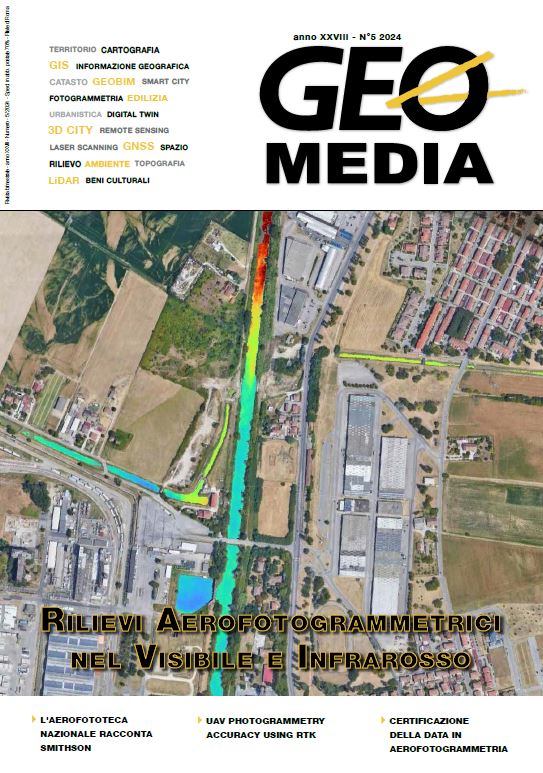Evaluation of the influence of the number of GCPS on the measurement quality of a photogrammetric block captured with an RTK UAV in geographical environments with high topographic roughness
Parole chiave:
survey, UAV, georeferencing, High positioning accuracy, photogrammetry, GCPAbstract
This study investigates the impact of using Ground Control Points (GCPs) on the measurement quality of photogrammetric blocks in high topographic roughness areas, captured with an RTK-enabled UAV. The research evaluates eight scenarios with varying numbers of GCPs to determine their effect on horizontal and vertical Root Mean Square Error (RMSE), Mean
Error (ME), and Standard Deviation Error (SDE). The study area was characterized by high topographic roughness, with a
UAV equipped with RTK GNSS used to capture images, and 117 control points (CP) established for accuracy assessment.
The UAV was flown in a double grid pattern with nadir and oblique images, ensuring 85% overlap. The GCPs were distributed
in different configurations across the area, ranging from zero to six GCPs per scenario. When no GCPs were used, the horizontal ME was 0.0693 m (X-axis) and 0.0686 m (Y-axis), while the vertical ME was significantly higher at -0.1781 m.
The SDE followed a similar trend, with the vertical SDE being the highest. The RMSE values were 0.0707 m (X-axis), 0.0701
m (Y-axis), and 0.1900 m (Z-axis), indicating substantial bias and variability, particularly in the vertical axis. The inclusion
of two GCPs had minimal impact on ME, but starting from three GCPs, ME decreased significantly, especially in the Z-axis.
The SDE remained consistent across different GCP scenarios, and the RMSE showed a marked reduction with the addition
of three GCPs, with no significant improvement observed beyond this number. The optimal number of GCPs was identified
as four to five, providing the best accuracy results without an unnecessary increase in GCPs. The study confirmed that using
RTK GNSS onboard UAVs enhances elevation accuracy, especially when coupled with a minimum number of GCPs. Significant
errors were noted in areas with abrupt elevation changes, and the central placement of a single GCP did not significantly
reduce RMSE. Linear regression analysis demonstrated a strong positive correlation between UAV RTK-derived elevations and terrestrial GNSS RTK measurements, with a high coefficient of determination (R² > 0.99). The spatial configuration of GCPs
was crucial, with edge placements proving more effective than central ones. Histograms of vertical differences between control
points and UAV RTK measurements indicated a systematic bias reduced with the addition of GCPs. The research also examined
the relationship between control point error and distance to the nearest GCP, finding no significant correlation. This study
underscores the importance of GCPs in improving the measurement quality of photogrammetric blocks in areas with high
topographic roughness. Without GCPs, UAV RTK systems were insufficient for achieving decimeter-level accuracy. Including
three to five GCPs significantly enhanced accuracy, with no substantial benefits beyond five GCPs. This finding suggests that
an optimal GCP configuration balances the number and placement to minimize errors efficiently. The research provides practical recommendations for UAV photogrammetry, emphasizing the need for adequate GCPs in complex terrains. Future studies should consider increasing the number of control points for better RMSE analysis and spatial error verification, and flight planning based on surface characteristics is advised to improve data accuracy in topographically complex areas. The findings and recommendations presented in this study offer valuable insights for researchers and practitioners using UAV photogrammetry, contributing to more precise and reliable data for various applications.
Riferimenti bibliografici
Benassi, F., Dall’Asta, E., Diotri, F., Forlani, G., Cella, U. M. di, Roncella, R., & Santise, M. (2017). Testing accuracy and repeatability of UAV blocks oriented with gnss-supported aerial triangulation. Remote Sensing, 9(2), 1–23. https://doi.org/10.3390/rs9020172
Bertin, S., Levy, B., Gee, T., & Delmas, P. (2020). Geomorphic change detection using cost-effective structure-from-motion photogrammetry: Evaluation of direct georeferencing from consumer-grade uas at orewa beach (new zealand). Photogrammetric Engineering and Remote Sensing, 86(5), 289–298. https://doi.org/10.14358/PERS.86.5.289
Bertin, S., Stéphan, P., & Ammann, J. (2022a). Assessment of RTK Quadcopter and Structure-from-Motion Photogrammetry for Fine-Scale Monitoring of Coastal Topographic Complexity. Remote Sensing, 14(7). https://doi.org/10.3390/rs14071679
Bertin, S., Stéphan, P., & Ammann, J. (2022b). Evaluación de cuadricóptero RTK y fotogrametría de estructura a partir del movimiento para el monitoreo a escala fina de la complejidad topográfica costera. Remote Sensing, 14(7). https://doi.org/10.3390/rs14071679
Cho, J. M., & Lee, B. K. (2023). GCP and PPK Utilization Plan to Deal with RTK Signal Interruption in RTK-UAV Photogrammetry. Drones, 7(4). https://doi.org/10.3390/drones7040265
Czy?a, S., Szuniewicz, K., Kowalczyk, K., Dumalski, A., Ogrodniczak, M., & Zieleniewicz, ?. (2023). Assessment of Accuracy in Unmanned Aerial Vehicle (UAV) Pose Estimation with the REAL-Time Kinematic (RTK) Method on the Example of DJI Matrice 300 RTK. Sensors, 23(4). https://doi.org/10.3390/s23042092
Elkhrachy, I. (2021). Accuracy Assessment of Low-Cost Unmanned Aerial Vehicle (UAV) Photogrammetry. Alexandria Engineering Journal, 60(6), 5579–5590. https://doi.org/10.1016/j.aej.2021.04.011
Kim, H., Hyun, C. U., Park, H. D., & Cha, J. (2023). Image Mapping Accuracy Evaluation Using UAV with Standalone, Differential (RTK), and PPP GNSS Positioning Techniques in an Abandoned Mine Site. Sensors, 23(13). https://doi.org/10.3390/s23135858
Liu, X., Lian, X., Yang, W., Wang, F., Han, Y., & Zhang, Y. (2022). Accuracy Assessment of a UAV Direct Georeferencing Method and Impact of the Configuration of Ground Control Points. Drones, 6(2). https://doi.org/10.3390/drones6020030
Oniga, V. E., Breaban, A. I., Pfeifer, N., & Chirila, C. (2020). Determining the suitable number of ground control points for UA images georeferencing by varying number and spatial distribution. Remote Sensing, 12(5). https://doi.org/10.3390/rs12050876
Padró, J. C., Carabassa, V., Balagué, J., Brotons, L., Alcañiz, J. M., & Pons, X. (2019). Monitoring opencast mine restorations using Unmanned Aerial System (UAS) imagery. Science of the Total Environment, 657, 1602–1614. https://doi.org/10.1016/j.scitotenv.2018.12.156
Park, J. W., & Yeom, D. J. (2022). Method for establishing ground control points to realize UAV-based precision digital maps of earthwork sites. Journal of Asian Architecture and Building Engineering, 21(1), 110–119. https://doi.org/10.1080/13467581.2020.1869023
Pourreza, M., Moradi, F., Khosravi, M., Deljouei, A., & Vanderhoof, M. K. (2022). GCPs-Free Photogrammetry for Estimating Tree Height and Crown Diameter in Arizona Cypress Plantation Using UAV-Mounted GNSS RTK. Forests, 13(11). https://doi.org/10.3390/f13111905
Stott, E., Williams, R. D., & Hoey, T. B. (2020a). Distribución de puntos de control terrestre para mapeo topográfico preciso a escala de kilómetros utilizando un vehículo aéreo no tripulado RTK-GNSS y fotogrametría SfM. www.mdpi.com/journal/drones
Traducido de linglés al español - www.onlinedoctranslator.com
Stott, E., Williams, R. D., & Hoey, T. B. (2020b). Ground control point distribution for accurate kilometre-scale topographic mapping using an rtk-gnss unmanned aerial vehicle and sfm photogrammetry. Drones, 4(3), 1–21. https://doi.org/10.3390/drones4030055
Štroner, M., Urban, R., Seidl, J., Reindl, T., & Brou?ek, J. (2021). Photogrammetry using UAV-mounted GNSS RTK: Georeferencing strategies without GCPs. Remote Sensing, 13(7). https://doi.org/10.3390/rs13071336
Taddia, Y., Stecchi, F., & Pellegrinelli, A. (2020). Coastal mapping using dji phantom 4 RTK in post-processing kinematic mode. Drones, 4(2), 1–19. https://doi.org/10.3390/drones4020009
Villanueva, J. K. S., & Blanco, A. C. (2019). Optimization of ground control point (GCP) configuration for unmanned aerial vehicle (UAV) survey using structure from motion (SFM). International Archives of the Photogrammetry, Remote Sensing and Spatial Information Sciences - ISPRS Archives, 42(4/W12), 167–174. https://doi.org/10.5194/isprs-archives-XLII-4-W12-167-2019
Yang, J., Li, X., Luo, L., Zhao, L., Wei, J., & Ma, T. (2022). New Supplementary Photography Methods after the Anomalous of Ground Control Points in UAV Structure-from-Motion Photogrammetry. Drones, 6(5). https://doi.org/10.3390/drones6050105
Zhang, K., Okazawa, H., Hayashi, K., Hayashi, T., Fiwa, L., & Maskey, S. (2022a). Optimization of Ground Control Point Distribution for Unmanned Aerial Vehicle Photogrammetry for Inaccessible Fields. Sustainability (Switzerland), 14(15). https://doi.org/10.3390/su14159505
Zhang, K., Okazawa, H., Hayashi, K., Hayashi, T., Fiwa, L., & Maskey, S. (2022b). Optimization of Ground Control Point Distribution for Unmanned Aerial Vehicle Photogrammetry for Inaccessible Fields. Sustainability (Switzerland), 14(15). https://doi.org/10.3390/su14159505
Dowloads
Pubblicato
Fascicolo
Sezione
Licenza

Questo volume è pubblicato con la licenza Creative Commons Attribuzione - Non commerciale - Condividi allo stesso modo 4.0 Internazionale.
Gli autori che pubblicano su questa rivista accettano le seguenti condizioni:- Gli autori mantengono i diritti sulla loro opera e cedono alla rivista il diritto di prima pubblicazione dell'opera, contemporaneamente licenziata sotto una Licenza Creative Commons - Attribuzione che permette ad altri di condividere l'opera indicando la paternità intellettuale e la prima pubblicazione su questa rivista.
- Gli autori possono aderire ad altri accordi di licenza non esclusiva per la distribuzione della versione dell'opera pubblicata (es. depositarla in un archivio istituzionale o pubblicarla in una monografia), a patto di indicare che la prima pubblicazione è avvenuta su questa rivista.
- Gli autori possono diffondere la loro opera online (es. in repository istituzionali o nel loro sito web) prima e durante il processo di submission, poiché può portare a scambi produttivi e aumentare le citazioni dell'opera pubblicata (Vedi The Effect of Open Access).





